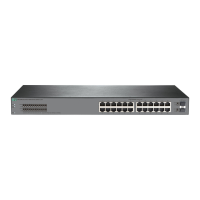101
Figure 35 DNS proxy application
A DNS proxy operates as follows:
1. A DNS client considers the DNS proxy as the DNS server, and sends a DNS request to the
DNS proxy. The destination address of the request is the IP address of the DNS proxy.
2. The DNS proxy searches the local static domain name resolution table and dynamic domain
name resolution cache after receiving the request. If the requested information is found, the
DNS proxy returns a DNS reply to the client.
3. If the requested information is not found, the DNS proxy sends the request to the designated
DNS server for domain name resolution.
4. After receiving a reply from the DNS server, the DNS proxy records the IP address-to-domain
name mapping and forwards the reply to the DNS client.
If no DNS server is designated or no route is available to the designated DNS server, the DNS proxy
does not forward DNS requests.
DNS spoofing
As shown in Figure 36, DNS spoofing is applied to the dial-up network.
• The device connects to a PSTN/ISDN network through a dial-up interface. The device triggers
the establishment of a dial-up connection only when packets are to be forwarded through the
dial-up interface.
• The device acts as a DNS proxy and is specified as a DNS server on the hosts. After the dial-up
connection is established, the device dynamically obtains the DNS server address through
DHCP or another autoconfiguration mechanism.
Figure 36 DNS spoofing application

